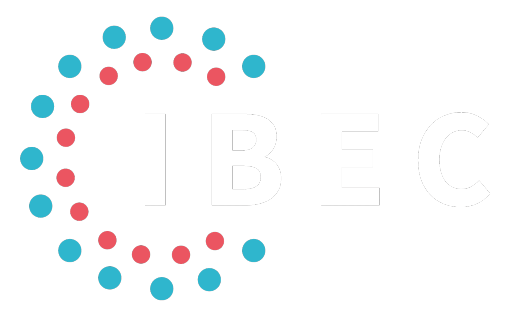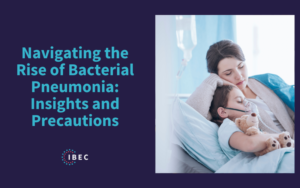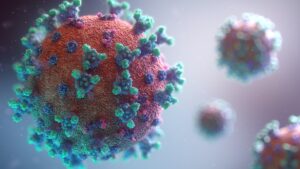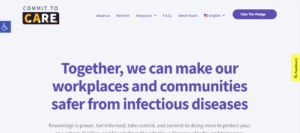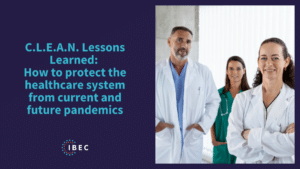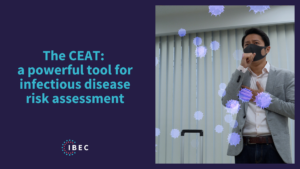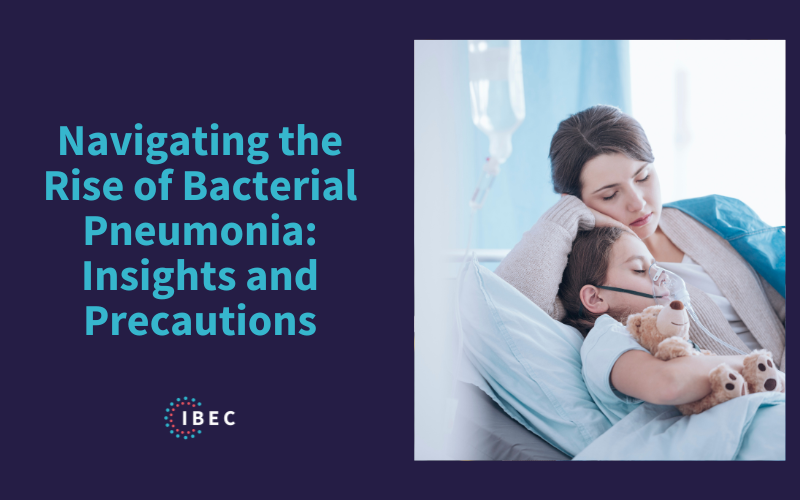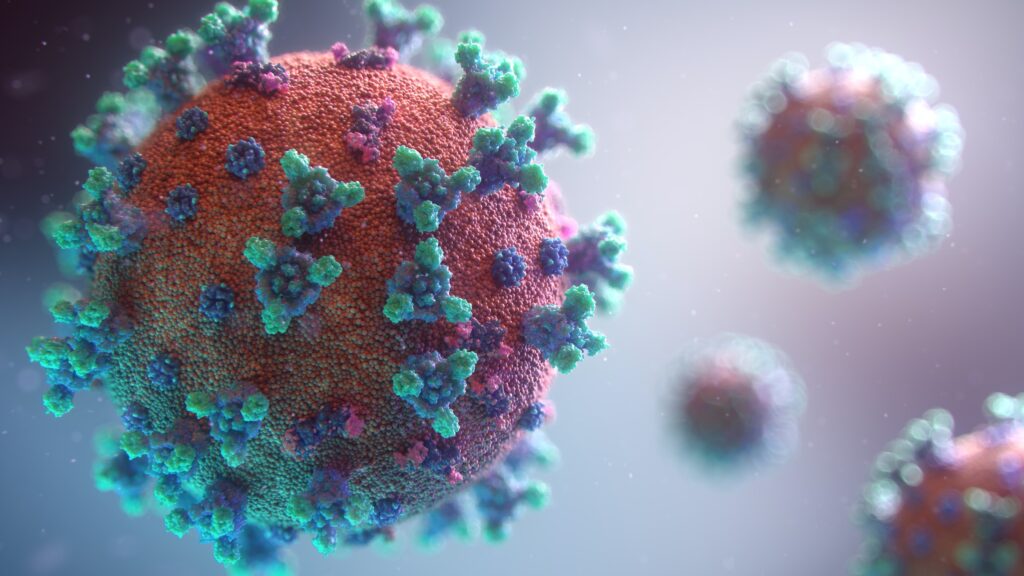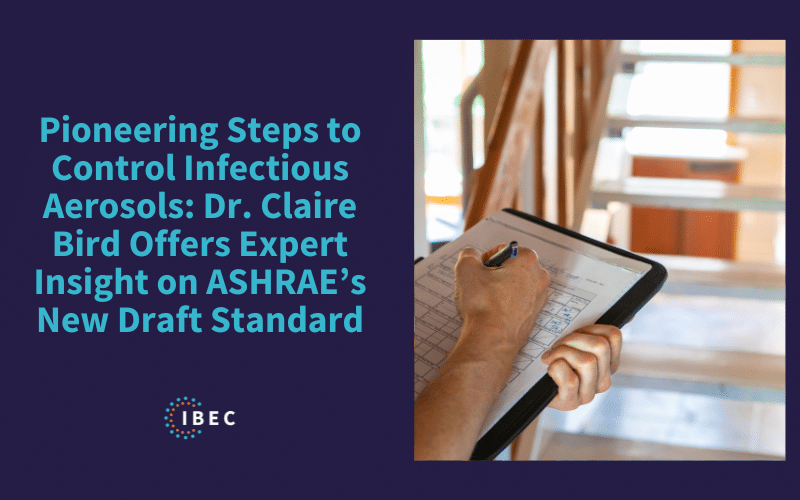Interdisciplinary Collaboration in Environmental Science: Pioneering Health Solutions with IBEC’s New CSO
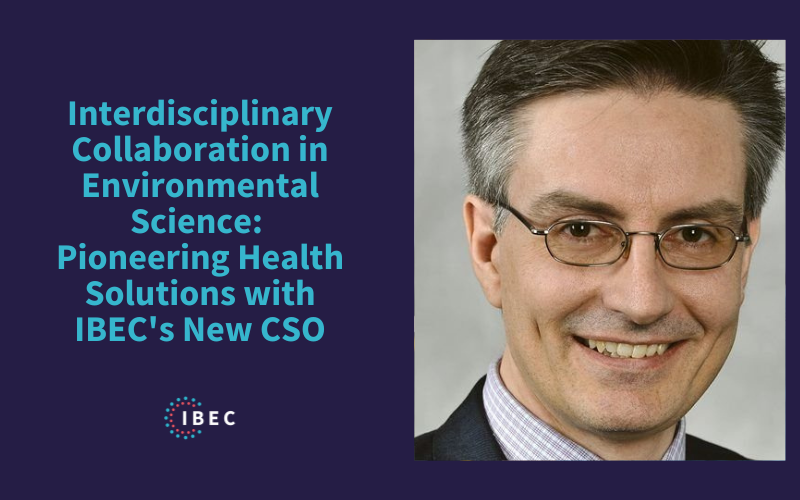
The Integrated Bioscience and Built Environment Consortium (IBEC) proudly introduces its new Chief Scientific Officer (CSO), Stephane Bilodeau.
Bringing over 25 years of diverse experience in science and technology, Stephane embodies the spirit of innovation and interdisciplinary collaboration that defines IBEC. In this exclusive interview, we delve into his professional journey, inspirations, and vision for IBEC’s future, offering a unique glimpse into the mind of a leader poised to make significant impacts in environmental and health sciences.
_____________________________________________________________________________________
Can you tell us about your professional journey and what led you to your current role as CSO at IBEC?
I have over 25 years of experience in various fields of science and technology. My journey started in the realms of science, thermodynamics, and engineering, where I specialized with an emphasis on indoor air quality, climate, and health.
I served as an associate and adjunct professor, initially at the University of Sherbrooke in Quebec and more recently in the bioengineering department at McGill University in Montreal. Additionally, I am the Chief Technology Officer of a clean tech company based in Plattsburgh, New York, which is conveniently located about 60 miles from Montreal. In this role, I have been leading and continue to lead the development of innovative technologies aimed at reducing environmental impact in buildings and industrial settings. My work primarily focuses on innovative solutions for sustainable development and addresses key climate issues.
I am also engaged as an independent international contractor with the United Nations, specifically with the Office of Project Services. My involvement spans various projects related to healthcare settings and institutional buildings. Additionally, I serve as the coordinator of the Indoor Air Quality Task Force at the World Health Network and chair the Public Affairs Advisory Committee of Engineers, an association representing regulatory bodies across all Canadian provinces, boasting approximately 300,000 members. My experience is diverse, encompassing collaborations with industrial partners, government agencies, and various stakeholders, always focusing on devising solutions to challenges in the built environment. This experience closely aligns with the essential aspects of IBEC. It also involves working with stakeholders to build a scientific and technical framework that ensures solutions are sound and practical, facilitating their implementation and deployment.
I have established extensive collaborations with many experts across various fields, including engineering, biomedical sciences, microbiology, environmental science, and more. These efforts in fostering collaboration have been a significant part of my work. This approach led me to discover IBEC through our founding of the Canadian Aerosol Transmission Coalition, which collaborated with IBEC. This collaboration occurred primarily in the early years of the pandemic. Since then, I have been consistently impressed by all that IBEC has accomplished and released. My passion for bridging the gap between science and practical application was ignited by what IBEC is doing, leading to my current role as the Chief Scientific Officer (CSO) of IBEC. We can achieve even more by working closely with industry partners, governmental agencies, and other stakeholders. I am eager to be a part of this and to contribute to making it happen.
How would you summarize the key element missing in bridging the gap between scientific recommendations and their practical application, particularly considering the varying socio-economic realities and inequitable access to solutions across regions like the United States, Canada, Australia, England, and Latin America?
I believe one of the most crucial aspects we need to focus on is collaboration. As I mentioned earlier, my diverse background spans academia, industry, and governmental and private sectors. Therefore, it’s essential to establish collaborations with various stakeholders across different industries, broadly speaking. This includes partnerships from the public to private sectors, encompassing the industry as the private component, communities, and the healthcare sector.
For example, our science advisory board requires diverse views and backgrounds. This is one instance of our collaboration with other organizations that share their unique perspectives. I advocate for what I call a constructive, collaborative approach. It’s not just about engaging in discussions with others but also about tailoring and adapting our solutions to ensure they are accepted. As you correctly pointed out, the science is quite clear on many solutions and mitigation strategies we should adopt. While new solutions are emerging, the fundamentals are confirmed. The challenge lies more in the decision-making aspect.
Sometimes, the challenge lies in engaging decision-makers at the community and grassroots levels. People need to understand and see how these scientifically sound solutions can be applied in their own realities and situations. If I were to summarize in a few words or even one word, it would be ‘collaboration,’ coupled with a diversity of individuals and groups.
Who or what has been your biggest inspiration or influence in your scientific and professional career?
I have had many influencers in my life. Looking back to the onset of my scientific career, which began well before I became a scientist, my first influencer was a significant figure, Leonardo da Vinci. He was an integrator of multiple fields and experiences and, notably, a very open-minded person.
Leonardo da Vinci, who was not only a painter but also well-versed in biology, engineering, and medical science, could integrate these disciplines into his various creations. He utilized his creativity along with an open-minded, innovative thinking approach. In fact, I consider him to be the very first bioengineer. This is what I often tell my students. He is an exemplary figure for multidisciplinarity, embodying both openness to other disciplines and the essence of interdisciplinarity and multidisciplinarity. He is one of my role models.
Another significant influence in my life and I’ll limit it to just one more, is Ban Ki-moon. He served as the Secretary-General of the United Nations from 2007 to 2016. I had the opportunity to meet and speak with him in 2019 in the context of that year’s UN General Assembly. He strongly advocates collaboration, sustainability, and reducing global inequalities. Notably, he played a key role in adopting the Paris Agreement on climate change. He is my second role model, particularly as a specialist in international collaboration. When I spoke earlier about collaboration in response to your question, I specifically referred to international and diverse cooperation. Having had the chance to speak with him personally makes this connection even more significant for me.
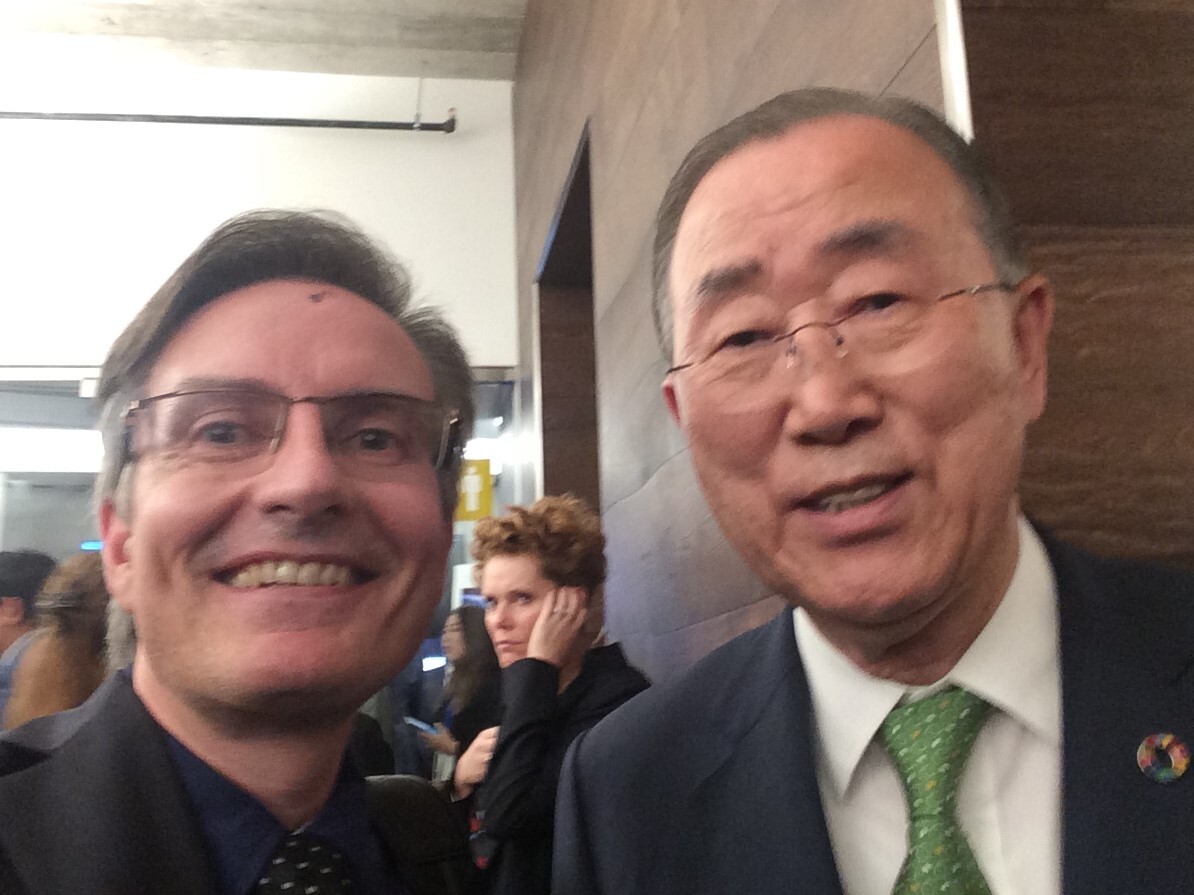
Picture of Stephane Bilodeau and Ban Ki-Moon in 2019
Leonardo da Vinci has been a significant figure in my mind, reflecting on something I read when I was just 10 years old. It was the first time I came into contact with his work, and for some reason, he was the topic I chose when my teacher asked us to select a subject for a class project. I still don’t fully understand why I chose him, but it profoundly influenced many of the things I did afterward.
Nonetheless, my greatest inspiration comes from discussing science, technology, and real-world issues with various wonderful people throughout my life. I have been fortunate to converse with bright minds and exchange ideas with people from various countries and backgrounds. This diversity of interactions is, for me, the most significant source of inspiration.
What significant challenges have you faced in your career, and how have they shaped your approach as a leader in the scientific community
The first challenge lies in balancing scientific rigor, or exactitude, and real-world practicality. In science, we sometimes forget that theories must be applicable and accepted in practical scenarios. I’ve learned this the hard way through working on various innovations. Part of my journey involved dealing with some innovations that were somewhat impractical, and this experience was a significant part of my learning process and helped me develop the skills to turn ideas into practical solutions..
It’s important to embrace learning, so I don’t view it as a problem but a challenge. I’ve held leadership roles in both the private and public sectors and have observed this issue in both realms. There’s often a kind of disconnect, though not a complete one. It’s more like a slight difference that complicates discussions. It’s akin to having two versions of the same language, where sometimes the differing tones and nuances make communication challenging. Therefore, we need to find effective ways to ensure proper communication occurs.
The second challenge, especially prevalent in smaller organizations, whether they operate on a volunteer or private basis, is consistently dealing with limited resources. Working within these constraints has almost become a science in itself. Therefore, it’s crucial to optimize the use of resources, including human resources, capital, and funding. The limitations inherent in these areas make it vital to strive for efficient resource utilization. Consequently, we must find methods to concentrate on the most important aspects.
We also need to establish collaborations. One solution to limited resources involves working with collaborators, other organizations, and individuals. This approach allows for the sharing of expertise, with each party working in their area of strength, making the process more efficient than attempting to handle everything alone. I have encountered this challenge in various forms, as mentioned, in both public and private sectors and even in volunteer settings. This constitutes the second major challenge. There are many others, but these two are particularly important in almost any organization I have encountered.
Where do you see yourself and IBEC in the next five years, and how do you plan to contribute to the organization’s growth and success?
That’s a good and important question. Let’s consider the five-year goal you’re referring to. I envision IBEC as becoming a leading player in the scientific community, particularly in the areas of environmental control solutions and infectious disease mitigation strategies. This involves integrating medical, technical, and various types of solutions. IBEC will work collaboratively as a key player, engaging with stakeholders from diverse backgrounds. I see IBEC emerging as a major player, certainly leading in its field within the next five years.
Indeed, IBEC will continue to concentrate on reducing infectious disease transmission and building. Still, I also foresee exploring the intertwined relationship between climate and health, delving deeper into their connection. I anticipate that the significance of climate on health, particularly regarding infectious diseases and many other aspects, will grow in the next few years. We are already witnessing an increase in the number of deaths globally due to air pollution and related factors, along with the emergence of diseases, some not entirely new but appearing in new places due to climate change altering the environment.
I see IBEC emerging as an important player in this area, and if we act swiftly, we can become a leading player, especially since this field is set to grow. The ties between climate and health are not as well-explored as in other scientific areas. As CSO, I plan to contribute to the organization’s growth as I described by leading discussions and exchanges in developing innovative solutions and mitigation strategies. These strategies will address both the current understanding of infectious diseases and the climate aspect of it.
Bridging the gap between science and the real world is the second area where I aim to contribute significantly. I believe reducing this gap in the next five years would be a tremendous achievement for the organization. Personally, I would be pleased to have contributed to this progress.
The third aspect is establishing strong partnerships with industry leaders, government agencies, or associations. This ensures that the solutions and discussions we put forward are emphasized and widely disseminated among the population and the decision-makers I referred to earlier. It’s crucial that we engage in constructive collaboration.
If we successfully spread this message, it will, in turn, aid in establishing collaborations. This creates a kind of positive cycle, as opposed to the vicious cycle that results from doing it the other way around. Thus, I am striving to contribute to establishing this positive feedback loop.
In the context of environmental control solutions and medical mitigation strategies, what are the key innovations or methods you believe are essential for reducing infectious disease transmission in buildings?
Firstly, I would say it is essential to implement several measures to both improve health and safety in buildings and reduce risks. We can start with the basics. One fundamental aspect, often overlooked in many situations, is having a proper ventilation system. This system should regulate fresh air flow, removing stale and contaminated air. Achieving this requires well-designed systems, which are improved and incorporate an increased level of filtration. A high-efficiency air filtration system is crucial. It’s a vital component of a good ventilation system and has often been neglected in the past. Whether built into the system from the start, which we don’t see much, or improved in many existing buildings, or even enhanced using portable systems like HEPA filters, it’s essential for air quality.
The second type of technology is UV disinfection, specifically the far-UVC, which is not widely used yet but is becoming increasingly known in the scientific community. I believe it’s the most desirable version of UV disinfection because it effectively kills viruses, bacteria, and other pathogens without harming human skin and eyes. This technology can be used in a variety of settings. For example, I would be cautious about using regular UVC in schools or homes, as improper installation or misuse can lead to risks such as cataracts and skin burns.
The advantage of far-UVC is that it operates at different wavelengths, offering built-in safety. While it’s not perfect, it is significantly safer than other forms of UVC. I foresee far-UVC becoming more popular in the future. What’s currently missing are commercial systems that can be easily implemented on a wider scale, but I think this is just a matter of time, as with many other technologies.
The third technology, which has not been extensively discussed yet in the infectious disease sector, is what I refer to as smart building technologies. This involves using Artificial Intelligence (AI) and the Internet of Things (IoT) to better control the building environment. The goal is to effectively manage pathogens and reduce the risk of infectious diseases.
This technology utilizes AI, tools, sensors, and other intelligent devices to determine when to open or close systems and alert people about various warnings. This will be integrated with ventilation and filtration systems, as well as far-UVC and other solutions. The idea is that smarter buildings will lead to smarter decision-making down the road. While these are just three technologies, focusing on them alone represents years of work, ensuring their potential and impact.
I am acquainted with a few European and US experts with whom we could collaborate and find ways to organize something. I definitely think far-UVC is a promising solution. It may not be a short-term fix, i.e., for tomorrow, but I see it becoming more relevant soon. UVC has already been rolled out, but as I mentioned, it’s a bit more complex to implement. So, it’s better suited for laboratories and hospitals settings. It’s certainly feasible there, but I’m considering widespread usage in settings like schools and homes, which do not have the capacity to monitor and manage the system as a laboratory would.
What can we do better if another pandemic arises? What can IBEC do to ensure we are better prepared next time?
It’s a big and important question, and I don’t believe there is an absolute answer. However, it’s crucial that we reflect on it. Preparedness is indeed key. We, the global community, were not fully prepared for the pandemic, yet at the same time, I can see that there had been decades of preparation. Starting about 120 years ago in Canada, where I live, a significant inquiry resulted in a comprehensive report. This report explicitly mentioned that the disease was airborne and highlighted the need for N95 masks, among many other things. These recommendations were related to the precautionary principle, which I believe was already defined in a report around 2008, though I’m not exactly sure of the year. It’s a complex issue, but reflecting on our preparedness and response is essential.
A couple of years after that report, about ten years later, COVID-19, the original strain, emerged. This report, however, was seemingly disregarded, like flushing it down the toilet. It’s not only important to think about what we’ll do if something like this happens again, but we also need to ensure that our systems around the world – our jurisdictions and public health authorities – are prepared to react appropriately. This isn’t just for the distant future; it’s relevant now.
COVID is still present. In Canada, where I’m from, the JN.1 variant is still a significant concern. Statistics Canada, our governmental statistical body, recently released data indicating that a significant fraction of Canadians are experiencing long COVID consequences. It’s somewhat analogous to what DHHS in the UK reported, where three or four percent of people were having long COVID symptoms. The situation is even more severe in Canada, with a couple of percent more people affected.
However, it’s within the same range. According to a recent Canadian report, each time individuals contract COVID, they increasingly risk experiencing long COVID consequences – this is currently the case, not two or three years ago, nor before the COVID emergency was downgraded last year by the WHO, CDC, and others.
Everyone who contracts COVID is more likely to develop long COVID. Therefore, we must enhance our preparedness tools, utilize them effectively, and apply them now. The challenge is finding ways to convince people and help them understand and know what is happening. The information I just shared has not been widely reported, not only in the US or Europe but even in Canada. The lack of reporting is likely because mainstream media does not deem it important for various reasons – perhaps it doesn’t generate enough clicks, or maybe there are other factors; I’m not certain.
To simplify my response: We missed effective communication to the general public in our preparedness post-SARS and leading into SARS-CoV-2. If the public understands what’s happening, it will drive action in governmental agencies, because when the public demands change, agencies are more likely to respond. We need to ensure this communication happens. I believe IBEC can be a tool to facilitate this, but it’s not a straightforward task. It’s a tough challenge – not an easy one, but a necessary one. Your question has prompted me to consider incorporating this into our objectives in the coming years.
How can IBEC communicate the importance of change and preparedness to the public while navigating political polarization in the US and maintaining its bipartisan stance without being labeled politically biased?
That’s a valid point. In most Western countries, and even beyond, there is growing polarization, which has taken a unique aspect in the US due to the country’s global economic influence. However, this polarization exists almost everywhere, at varying levels. It’s crucial for an organization like IBEC to find ways to engage with all stakeholders. While not all may be receptive, if our messaging is consistently based on science and not directly tied to any political orientation, it can have broader appeal. Some people might find it easier to accept based on political leanings, while others might not.
For instance, a few years ago, there were many climate change deniers in the US. Now, the narrative has shifted. They might not fully agree on the necessary actions, but they no longer deny the fact that the planet is warming. This evolution shows the importance of steadfast scientific communication. Indeed, the events of this past summer were so significant that it’s become impossible to ignore them.
However, the situation then becomes more complex. For example, some people criticize certain technologies, like claiming that wind power is dangerous for birds, to sideline the core issue. But outright denial is no longer the norm. I believe that if we can present science more efficiently than was done with climate science, which took 30 years to gain widespread recognition, we can achieve faster progress. There’s definitely a way to do this, and the evolving response to climate change is one example of how public perception can shift over time.
The second example is that of cigarettes. I’m over 50 now, and when I was younger, doctors were among the biggest smokers. But now, the narrative has completely shifted. Who would argue today that smoking is not dangerous? It’s a clear example of how public opinion can change, even on topics that were once highly polarized and viewed from a one-sided perspective.
The third example is from a time older than that, more than 60 years ago when lead was added to vehicle gasoline to make it more efficient. However, this led to lead contamination everywhere and people getting intoxicated. But that has also changed, driven partly by economic interests and other factors. So, in the past, it has been possible to bring about change, and I believe we can do the same with health. Health has become a crucial concern for people on both sides, and they want to take care of it.
So, they do not necessarily use the same approach or discourse as with climate change, but at the core, they understand the importance of health, both their own and that of their loved ones. It’s a fundamental concern. I believe we can go back to basics and, over time, hopefully not taking 30 years, find a more efficient way to address it. I remain optimistic, although I acknowledge that it’s quite challenging.
Multiple solutions make it easier for some to adopt them than others. As I mentioned, this is why we need to offer several solutions. We don’t require 100% compliance but rather a significant majority. Just like there was, held in the recent years, a convention with 500 Flat Earthers, rejecting the fact that the “Globe” is a sphere, some may resist accepting scientific facts about health. However, our goal is not to achieve 100% compliance, as that’s impossible. Instead, we aim for a large majority that can influence decision-makers to ensure the deployment of practical, feasible, and affordable solutions. The key here is to offer many solutions, not a one-size-fits-all approach.
Would you like to share any additional insights or topics we haven’t discussed yet during our conversation today?
I just want to reiterate that one of the key things for IBEC in the next few months and years, in my opinion, is establishing this collaboration that will serve multiple purposes. It will benefit the scientific and academic side by providing a wider spectrum of possibilities and solutions. As I mentioned before, we need many solutions. Collaboration is key, and it will also facilitate exchanges with different groups and stakeholders, which will aid in the communication efforts.
I believe that communication is something we should not neglect. We need to find ways to connect with various parties, not political parties, but different groups, associations, and categories of people. While we are based on science, it’s also essential to reach out to other groups.
Networking will play a crucial role in this, and I wanted to highlight that it’s a key future aspect. I hope to contribute to this effort, so I’m more broadly here today with you and the organization. These are key points I wanted to ensure are emphasized correctly.
Connect with Stephane Bilodeau through LinkedIn here.
_____________________________________________________________________________________
As IBEC welcomes its new CSO, we stand on the brink of exciting advancements in bio-environmental science. His vision, grounded in decades of experience and a passion for practical solutions, paves the way for innovative approaches to global health and environmental challenges. His leadership is not just about scientific advancement but also about inspiring collaborative efforts for a sustainable and healthier future.
Join us in welcoming Stephane and be part of the conversation as we embark on this journey towards innovative environmental solutions. Follow IBEC’s latest initiatives and contribute to the mission of transforming scientific ideas into practical solutions for a better tomorrow.
Related Blogposts
Navigating the Rise of Bacterial Pneumonia: Insights and Precautions
Navigating the Rise of Bacterial Pneumonia: Insights and Precautions As winter’s chill sets in, health professionals and organizations brace for the annual uptick in respiratory…
New COVID-19 Variant JN.1 Raises in the United States
JN.1 is a highly contagious, fast-spreading subvariant of omicron that has become the dominant strain in the country. According to data from the Centers for…
Pioneering Steps to Control Infectious Aerosols: Dr. Claire Bird Offers Expert Insight on ASHRAE’s New Draft Standard
As we navigate through the challenges posed by the COVID-19 pandemic and other airborne diseases, there is a dire need to implement measures that will…
IBEC Takes the Lead in Developing a Framework for Reducing Indoor Pathogen Transmission
Dear IBEC Partners and Supporters, As we continue to navigate the ongoing threat of airborne pathogens transmission in our shared indoor communities, it’s more important…
New Commit To C.A.R.E. Resources Deliver Innovative Indoor Air Quality Solutions for Safer Workplaces
The Commit to C.A.R.E initiative The Integrated Bioscience and Built Environment Consortium (IBEC) and The American Industrial Hygiene Association (AIHA), two leading organizations committed to…
Staying Ahead of Severe GAS Infections and Other Secondary Bacterial Infections
Severe Group A Streptococcal (GAS) infections, including invasive disease (iGAS), can lead to life-threatening illness and death. CDC is looking into an increase in…
Industry Leader L’Oréal Pledges to Support Commit to C.A.R.E.
Industry Leader L’Oréal Pledges to Support Commit to C.A.R.E. With health experts warning of the triple threat of the continued spread of new COVID-19…
C.L.E.A.N. Lessons Learned: How to protect the healthcare system from current and future pandemics
The COVID-19 pandemic caught the world off guard. Health organizations all over the globe rushed into a quick response to protect people from the threat…
The CEAT: a powerful tool for infectious disease risk assessment
The CEAT is a powerful tool for infectious disease risk assessment. Keep reading to learn about its development and use. We will never forget March…
Best ways to be safe from COVID-19 in public transport
Since the beginning of the pandemic, industrial hygienists have been researching and broadcasting the information needed to prevent the infection & spread of COVID-19. Under…
Navigating the Rise of Bacterial Pneumonia: Insights and Precautions
Navigating the Rise of Bacterial Pneumonia: Insights and Precautions As winter’s chill sets in, health professionals and…
New COVID-19 Variant JN.1 Raises in the United States
JN.1 is a highly contagious, fast-spreading subvariant of omicron that has become the dominant strain in the…
Pioneering Steps to Control Infectious Aerosols: Dr. Claire Bird Offers Expert Insight on ASHRAE’s New Draft Standard
As we navigate through the challenges posed by the COVID-19 pandemic and other airborne diseases, there is…
